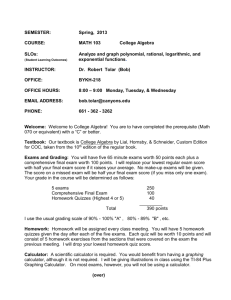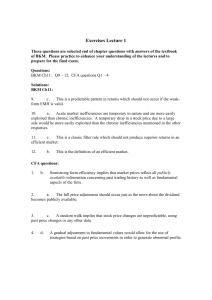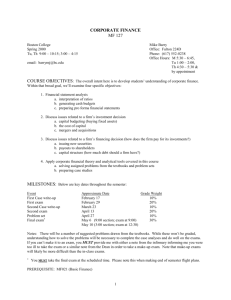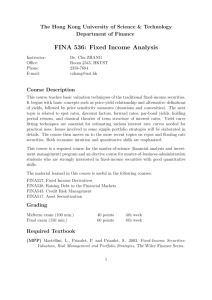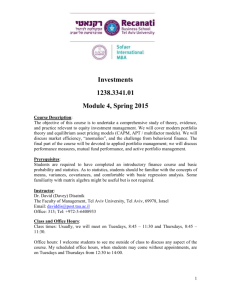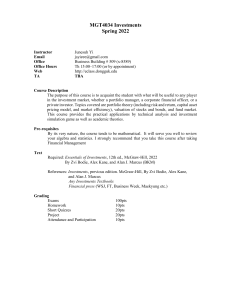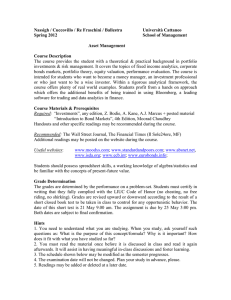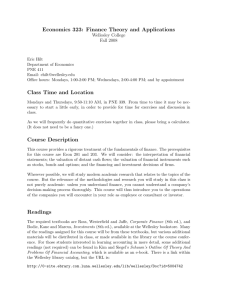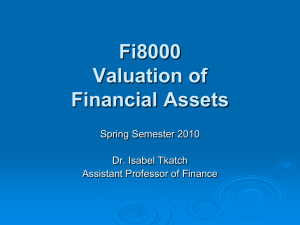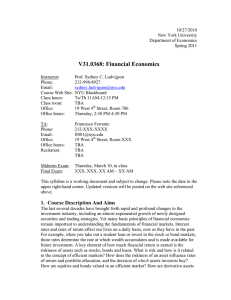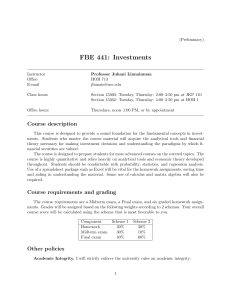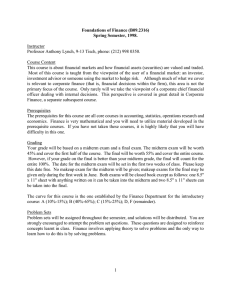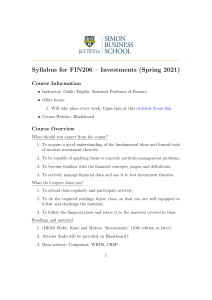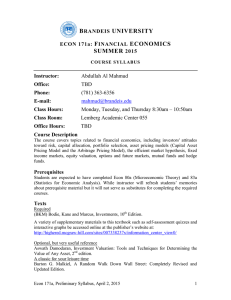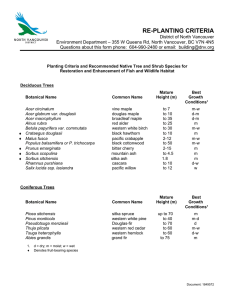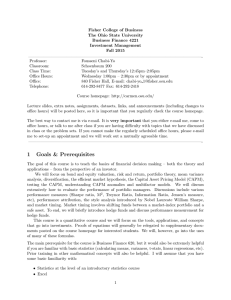Foundations of Finance
advertisement
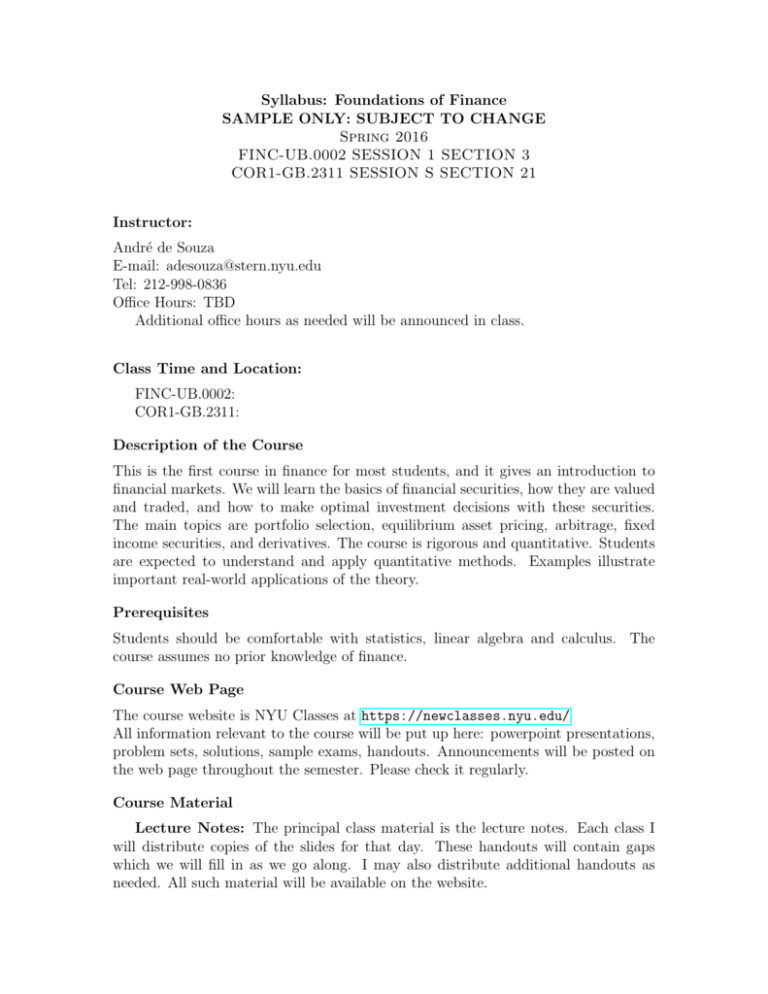
Syllabus: Foundations of Finance SAMPLE ONLY: SUBJECT TO CHANGE Spring 2016 FINC-UB.0002 SESSION 1 SECTION 3 COR1-GB.2311 SESSION S SECTION 21 Instructor: André de Souza E-mail: adesouza@stern.nyu.edu Tel: 212-998-0836 Office Hours: TBD Additional office hours as needed will be announced in class. Class Time and Location: FINC-UB.0002: COR1-GB.2311: Description of the Course This is the first course in finance for most students, and it gives an introduction to financial markets. We will learn the basics of financial securities, how they are valued and traded, and how to make optimal investment decisions with these securities. The main topics are portfolio selection, equilibrium asset pricing, arbitrage, fixed income securities, and derivatives. The course is rigorous and quantitative. Students are expected to understand and apply quantitative methods. Examples illustrate important real-world applications of the theory. Prerequisites Students should be comfortable with statistics, linear algebra and calculus. The course assumes no prior knowledge of finance. Course Web Page The course website is NYU Classes at https://newclasses.nyu.edu/ All information relevant to the course will be put up here: powerpoint presentations, problem sets, solutions, sample exams, handouts. Announcements will be posted on the web page throughout the semester. Please check it regularly. Course Material Lecture Notes: The principal class material is the lecture notes. Each class I will distribute copies of the slides for that day. These handouts will contain gaps which we will fill in as we go along. I may also distribute additional handouts as needed. All such material will be available on the website. Textbooks (recommended but not required): The textbooks below are recommended but NOT required. Having a textbook will help solidify your understanding, as a backup source where you can reread material we cover in class, and by presenting material from another point of view. You are encouraged to buy the textbooks, but I do not insist upon it. Homework will only require an understanding of what is covered in class, and examinations will test you only on the material contained in the lecture notes and homeworks. 1. (BKM) Bodie, Kane, and Marcus, “Investments”, 10th edition 2. (S) Bodie, Kane, and Marcus, “Investments (10th edition): Solutions Manual”. 3. (RWJ) Ross, Westerfield, and Jordan, “Essentials of Corporate Finance”, Custom Edition (includes Chapter 4, 5 and 8) The class material is generally covered by BKM. If you have an earlier edition of BKM (later than sixth) you should be fine. The link between what we cover in class and what BKM covers is mostly strong, but sometimes weak. It is, however, the best book available for our purposes. The solutions manual (S) will help with practice problems. The custom edition of RWJ corresponds to material covered in 2-3 classes. Calculator (required): You need a calculator for this class. It is a small advantage to have a financial calculator, but not a requirement. All the problems in this class can be answered with a regular one, as long as it can take powers and calculate logarithms. I will not assume you have a financial calculator. Standard financial calculators include, for instance, Hewlett Packard 12C and 10B. You are supposed to learn how to use it on your own or with your group. Grading There will be weekly assignments, a midterm exam and a final. The breakup is: Assignments Participation Midterm Final 10% 10% 40% 40% Details follow. Problem Sets: Problem sets will be handed out weekly. They will graded on a 1 to 3 scale, and you will be given full credit if you have made a good-faith effort to answer all of the questions. Problem sets must be handed in, in hard copy, at the beginning of the class in which they are due. Late problem sets will not be accepted. You may work in groups on the problem sets, but each person must write up and submit his or her own copy. You are not to just print two copies of the same document with different names on them. Exams: The exams will be based on homework problems and the material taught in class. The final exam is not cumulative. The examinations will be open notes, but not open book. You will be allowed to bring any printed/photocopied/handwritten 2 paper in, but no books. The exams will be designed to test your understanding rather than your memory, and will therefore be somewhat hard. Curve: The Stern Finance department provides an approximate grade distribution which I will follow. 3 A list of topics is below. I will identify the links to the material in the textbook. Schedule Item Topic 1. 2. 3. 4. 5. 6. 7. 8. 9. 10. Introduction, Financial Instruments, Financial Markets Time Value of Money Risk and Return Diversification, Efficient Portfolios, Optimal Portfolios Equilibrium: The Capital Asset Pricing Model Efficient Market Hypothesis Arbitrage Equity Valuation Fixed Income Securities and Valuation Options Markets and Valuation 4
